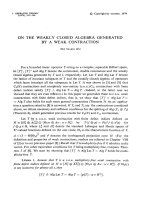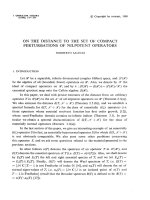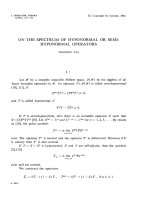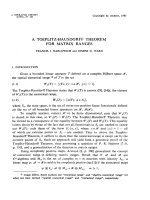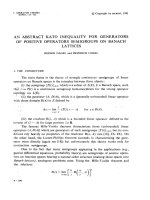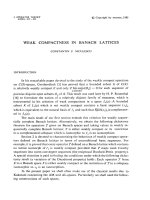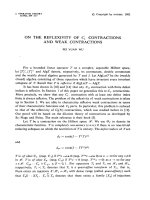Báo cáo toán học: "On the Sn-modules generated by partitions of a given shape" doc
Bạn đang xem bản rút gọn của tài liệu. Xem và tải ngay bản đầy đủ của tài liệu tại đây (148.6 KB, 12 trang )
On the S
n
-modules generated by
partitions of a given shape
Daniel Kane
1
and Steven Sivek
2
1
Department of Mathematics, Harvard University
2
Department of Mathematics, Massachusetts Institute of Technology
Submitted: May 12, 2008; Accepted: Aug 24, 2008; Published: Aug 31, 2008
Mathematics Subject Classification: 05E10
Abstract
Given a Young diagram λ and the set H
λ
of partitions of {1, 2, . . . , |λ|} of shape
λ, we analyze a particular S
|λ|
-module homomorphism QH
λ
→ QH
λ
to show that
QH
λ
is a submodule of QH
λ
whenever λ is a hook (n, 1, 1, . . . , 1) with m rows,
n ≥ m, or any diagram with two rows.
1 Introduction
Let λ = (λ
1
, . . . , λ
n
) be a Young diagram and let H
λ
be the set of row tabloids of shape λ:
that is, H
λ
is the set of all ways to fill the diagram with the numbers 1, 2, . . . , |λ| =
λ
i
such that the order within a given row does not matter and neither does the order of two
rows of the same size. Let V
λ
denote the set of column tabloids of shape λ, which are
defined analogously, and note that V
λ
∼
=
H
λ
canonically. In particular, H
λ
and V
λ
are
the sets of partitions of {1, 2, . . . , |λ|} of shape λ and λ
, respectively. Each of these sets
has an obvious S
|λ|
action obtained by permuting the numbers which fill the tabloids. For
any two tabloids Γ ∈ H
λ
and ∆ ∈ V
λ
we define an orthogonality relation Γ ⊥ ∆ to be
satisfied precisely when |r ∩ c| ≤ 1 for every row r of Γ and column c of ∆.
We define a homomorphism of S
|λ|
-modules QV
λ
→ QH
λ
in terms of a matrix K
λ
,
whose rows and columns are indexed by H
λ
and V
λ
respectively and whose entries K
λ
Γ,∆
are equal to 1 whenever Γ ⊥ ∆ and 0 otherwise. Then Pylyavskyy [5] conjectured that
K
λ
has full rank, modifying a false conjecture of Stanley [7]. This is of particular interest
due to work of Black and List [1], in which they introduced this homomorphism in the
case where λ is an n × m rectangle and showed that the conjecture would imply Foulkes’
plethysm conjecture as follows:
the electronic journal of combinatorics 15 (2008), #R111 1
Proposition 1.1 (Black and List). If K
n×m
has full rank for some n ≥ m > 1, then
the S(rn)-module QH
n×r
contains QH
r×n
as a submodule for 1 ≤ r ≤ m.
Unfortunately, this will not suffice to prove the full conjecture, since Mller and Neun-
hffer have shown that K
5×5
does not have full rank [4]. Furthermore, the second author
showed Pylyavskyy’s conjecture to be false in infinitely many cases: any diagram λ can
be nested in some larger µ such that K
µ
does not have full rank, and there are symmetric
shapes λ
n
such that
rank(K
λ
n
)
|H
λ
n
|
→ 0 as n → ∞ [6].
This paper is concerned with proving positive results about the matrices K
λ
. In order
to show that certain K
λ
have full rank, we construct a related matrix:
Definition 1.2. Let M
λ
= (K
λ
)(K
λ
)
T
for all shapes λ such that |H
λ
| ≤ |V
λ
|.
This matrix was diagonalized by Coker [2] in the rectangular cases λ = (n, n) as
well as λ = (m, m, m) for 3 ≤ m ≤ 6. Note that M
λ
is square (specifically |H
λ
| ×
|H
λ
|) and symmetric, hence diagonalizable, and it is positive semidefinite since v
T
M
λ
v =
|(K
λ
)
T
v|
2
≥ 0 for any vector v ∈ QH
λ
. Furthermore, it is easy to see from the definition
that the entries of M
λ
are indexed by pairs of row tabloids Γ
1
, Γ
2
∈ H
λ
, and that M
λ
Γ
1
,Γ
2
=
#{∆ ∈ V
λ
| Γ
1
, Γ
2
⊥ ∆}.
Proposition 1.3. Suppose that |H
λ
| ≤ |V
λ
|. Then the matrix M
λ
is invertible if and
only if (K
λ
)
T
: QH
λ
→ QV
λ
is injective.
Proof. If (K
λ
)
T
is injective, then for any nonzero vector v ∈ QH
λ
we have v
T
M
λ
v =
|(K
λ
)
T
v|
2
> 0, hence M
λ
v = 0; this implies that M
λ
is invertible. If however (K
λ
)
T
v = 0
for some nonzero v, then M
λ
v = K
λ
((K
λ
)
T
v) = 0 and so M
λ
is not invertible.
With this proposition in mind, we will show in the following sections that M
λ
is
invertible for several classes of Young diagrams, namely hooks and diagrams with two
rows, using a construction which is nearly identical in both cases. The case of hooks is
already known but seems to be unpublished (see [7, Problem 9]), and our proof in this
case is both new and relatively simple. It is therefore good preparation for the main
result, which establishes for the first time that QH
λ
is a submodule of QH
λ
whenever λ
is a diagram with two rows.
2 Hooks
An n × m hook is defined as the Young diagram λ = (n, 1, . . . , 1) with a total of m rows;
we will write it as n, m for convenience. Since any row tabloid Γ ∈ H
n,m
is uniquely
determined by its top row, we can think of these interchangeably as row tabloids and
n-element subsets of {1, 2, . . . , n + m − 1}. We will also define a function δ(Γ
1
, Γ
2
) as the
number of elements in the intersection of these subsets, so for example when n = 5 and
m = 3 we have δ({1, 2, 3, 5, 6}, {1, 2, 4, 6, 7}) = 3.
In this section we will describe the matrix M
n,m
, n ≥ m, and prove that it is in-
vertible, a result that was claimed without proof in [7]. The diagonal entries M
n,m
Γ,Γ
are
the electronic journal of combinatorics 15 (2008), #R111 2
clearly n, since each of these is the number of ∆ ∈ V
n,m
which are orthogonal to Γ; in
any such ∆, the n elements in the top row of Γ must each be in a different one of the
n columns of ∆, and we may choose exactly one of them to be in the m-element first
column. Otherwise, suppose that δ(Γ
1
, Γ
2
) = k < n. Any column tabloid ∆ which is
orthogonal to both Γ
1
and Γ
2
must place one element from the top row of each Γ
i
in each
column, so each of the n − 1 elements in the 1-element columns of ∆ must be in both the
top rows of Γ
1
and Γ
2
: that is, if δ(Γ
1
, Γ
2
) < n − 1 then there is no ∆ ∈ V
n,m
which is
orthogonal to both. Otherwise, if δ(Γ
1
, Γ
2
) = n − 1 then the n − 1 elements common to
their top rows must fill all of the 1-element columns of ∆, and this uniquely determines
the remaining m-element column of ∆, so there is exactly one ∆ orthogonal to both of
the Γ
i
. In summary, we have
M
n,m
Γ
1
,Γ
2
=
n if Γ
1
= Γ
2
1 if δ(Γ
1
, Γ
2
) = n − 1
0 otherwise.
We may attempt to show that M
n,m
is invertible by diagonalizing it. A series of
related computations using a combination of Sage and LinBox [8, 3] suggested many of
the following results.
Lemma 2.1. The minimal polynomial of M
n,m
has degree at most m.
Proof. Suppose that P and Q are two matrices whose entries are P
Γ
1
Γ
2
= p
k
and Q
Γ
1
Γ
2
=
q
k
whenever δ(Γ
1
, Γ
2
) = k. Then if R = P Q, we have
R
Γ
1
Γ
2
=
Γ
3
P
Γ
1
Γ
3
Q
Γ
3
Γ
2
.
If indeed δ(Γ
1
, Γ
2
) = k, then we may apply some permutation σ ∈ S
n+m−1
which will
take Γ
1
to the tabloid with top row {1, 2, . . . , n} and Γ
2
to the tabloid with top row
{1, 2, . . . , k, n + 1, . . . , 2n − k}, and it is easy to verify that the action of σ preserves
the value of δ and hence the terms P
Γ
1
Γ
3
and Q
Γ
3
Γ
2
, so R
Γ
1
Γ
2
depends not on the actual
tabloids Γ
i
but on δ(Γ
1
, Γ
2
). In particular, we may define sequences a
e
k
, n−m+1 ≤ k ≤ n,
so that (M
n,m
)
e
has (Γ
1
, Γ
2
)-entry equal to a
e,k
whenever δ(Γ
1
, Γ
2
) = k.
Now consider an arbitrary polynomial f(x) =
m
i=0
c
i
x
i
. The entries of f(M
n,m
) are
all of the form
m
i=0
c
i
a
i,k
, and there are m possible values of k but m + 1 coefficients c
i
,
so there is some nontrivial choice of the c
i
which makes each sum
c
i
a
i,k
equal to zero.
Therefore we can find a nonzero polynomial f, deg f ≤ m, such that f(M
n,m
) = 0.
Since M
n,m
is diagonalizable, its minimal polynomial is equal to the product
(x−λ)
over all distinct eigenvalues λ of M
n,m
. This means that the matrix has at most m
distinct eigenvalues, and in fact we can compute all of them:
Proposition 2.2. The eigenvalues of M
n,m
are precisely the values (n − k)(m − k) for
0 ≤ k < m.
the electronic journal of combinatorics 15 (2008), #R111 3
Proof. We will explicitly construct eigenvectors v
k
= (a
k,Γ
)
Γ∈H
n,m
for each value of k,
0 ≤ k < m, referring to each tabloid Γ by the set of elements in its first row for convenience.
Declare an n-element subset of {1, 2, . . . , n + m − 1} to be k-ordinary if it contains zero
or two elements of any one of the pairs {1, 2}, {3, 4}, . . . , {2k − 1, 2k}. A set which is not
k-ordinary, i.e. which has exactly one element from each of those pairs and thus n − k
elements of {2k + 1, . . . , n + m − 1}, is called k-even if it contains an even number of
odd elements up to 2k and k-odd otherwise. (Note that all n-element subsets are k-even
when k = 0.) Then for each Γ, we set a
k,Γ
= 0 if Γ is k-ordinary, a
k,Γ
= 1 if Γ is
k-even, and a
k,Γ
= −1 if Γ is k-odd. Write (b
Γ
) = M
n,m
(a
k,Γ
); we wish to show that
b
Γ
= (n − k)(m − k)a
k,Γ
for all Γ.
Suppose that Γ is k-ordinary. Then b
Γ
=
Γ
k−even
M
n,m
Γ,Γ
−
Γ
k−odd
M
n,m
Γ,Γ
, or
equivalently
b
Γ
= #{Γ
k−even | δ(Γ, Γ
) = n − 1} − #{Γ
k−odd | δ(Γ, Γ
) = n − 1}.
If either of these sets is nonempty, then either one of the pairs {1, 2}, . . . , {2k − 1, 2k}
has both elements in Γ, or one of the pairs does not intersect Γ and Γ contains at least
n − k + 1 elements of {2k + 1, . . . , n + m − 1}. In the first case, we may construct Γ
by
replacing either element of the pair; in the second case, we construct Γ
by replacing any
of the extra elements from {2k + 1, . . . , n + m − 1} with either element of the pair which
does not intersect Γ. In both cases the choice of an element from the pair in question
determines the k-parity of Γ
, and since we may choose either one freely it is clear that
there are equal numbers of k-even and k-odd Γ
. In particular, this means that b
Γ
= 0
whenever a
k,Γ
= 0.
If instead Γ is k-even, then b
Γ
= n + #{Γ
k−even | δ(Γ, Γ
) = n − 1} − #{Γ
k−odd |
δ(Γ, Γ
) = n − 1}. The only way to construct k-even Γ
with δ(Γ, Γ
) = n − 1 is to replace
one of the n− k elements in {2k +1, . . . , n +m− 1}∩Γ with one of the m−k −1 elements
in {2k + 1, . . . , n +m− 1}\Γ, so there are (n− k)(m−k − 1) such Γ
. In order to construct
k-odd Γ
with δ(Γ, Γ
) = n − 1, we must choose one of the k pairs {1, 2}, . . . , {2k − 1, 2k}
and replace the element of that pair in Γ with the other element, hence clearly there are
k such Γ
. Therefore
b
Γ
= n + (n − k)(m − k − 1) − k = (n − k)(m − k).
An identical computation yields b
Γ
= −(n − k)(m − k) when Γ is k-odd, so M
n,m
v
k
=
(n − k)(m − k) · v
k
as desired.
Theorem 2.3. The matrix M
n,m
is invertible for all n ≥ m ≥ 2. Therefore K
n,m
has
full rank.
Proof. None of the eigenvalues of M
n,m
are zero.
Although we have computed all of the eigenvalues of M
n,m
, we have not actually
shown how to diagonalize it because we do not know the multiplicities of each eigen-
value. The same series of computations which initially suggested Proposition 2.2 seems
to support the following conjecture:
the electronic journal of combinatorics 15 (2008), #R111 4
Conjecture 2.4. The S
n+m−1
-orbit of v
k
spans a subspace of H
n,m
of dimension equal
to
n+m−1
k
−
n+m−1
k−1
. These subspaces are precisely the eigenspaces with eigenvalues
(n − k)(m − k).
Finally, we note that the matrices K
n,n
are square and symmetric, so M
n,n
=
(K
n,n
)
2
. In this case the eigenvalues of M
n,n
all have the form (n − k)
2
, so in fact
K
n,n
has integer eigenvalues. Also, if Conjecture 2.4 is true, then M
n,n
has 1 as an
eigenvalue with multiplicity
2n−1
n−1
−
2n−1
n−2
=
1
n+1
2n
n
, which is the nth Catalan number.
3 Young diagrams with two rows
In this section we will consider all Young diagrams of the shape λ = (n, m), where
n > m ≥ 1. This does not cover precisely all shapes with two rows, since it omits 2 × n
rectangles λ = (n, n), but this case was already solved by diagonalizing M
λ
in [2] and by
a short combinatorial argument in [5].
Proposition 3.1. The matrices K
(n,n)
and K
(n,n−1)
are identical for all n ≥ 2.
Proof. We construct bijections f : H
(n,n)
→ H
(n,n−1)
and g : V
(n,n)
→ V
(n,n−1)
by taking
tabloids Γ ∈ H
(n,n)
or ∆ ∈ V
(n,n)
, removing the square containing 2n from its respective
row or column, and possibly reordering the rows or columns of the resulting shape so that
the shortened one appears last. It is clear that Γ ⊥ ∆ if and only if f(Γ) ⊥ g(∆), so
K
(n,n)
Γ,∆
= K
(n,n−1)
f(Γ),g(∆)
for all Γ and ∆.
Since K
(n,n)
has full rank, it follows that K
(n,n−1)
has full rank as well and thus we
may now restrict our analysis to the case m ≤ n − 2.
Given n > m, we can define a function δ on pairs of row tabloids of shape (n, m)
just as in the case of hooks, by letting δ(Γ
1
, Γ
2
) be the number of elements which appear
in the top row of both tabloids; note that we have n − m ≤ δ(Γ
1
, Γ
2
) ≤ n. Suppose
that δ(Γ
1
, Γ
2
) = k, and without loss of generality assume that the top rows of Γ
1
and
Γ
2
are {1, 2, . . . , n} and {1, . . . , k, n + 1, . . . , 2n − k} respectively. In a column tabloid
∆ ∈ V
(n,m)
which is orthogonal to both Γ
1
and Γ
2
, any element in one of the 1-element
columns must be in the top row of each Γ
i
, or else two elements from the top row of one
Γ
i
will end up in the same column somewhere else; there are thus
k
n−m
ways to fill these
columns. The remaining k − n + m elements of {1, 2, . . . , k} must be paired with elements
of {2n − k + 1, . . . , n + m} in 2-element columns of ∆, and there are (k − n + m)! ways
to do so. Finally, the elements {k + 1, . . . , n} from the top row of Γ
1
must be paired with
{n + 1, . . . , 2n − k} in the remaining 2-element columns of ∆, and this can be done in
(n − k)! ways. Therefore there are a total of
k
n−m
· (k − n + m)! · (n − k)! column tabloids
orthogonal to both Γ
1
and Γ
2
, or
M
(n,m)
Γ
1
,Γ
2
=
k!(n − k)!
(n − m)!
=
n!
(n − m)!
n
k
−1
whenever δ(Γ
1
, Γ
2
) = k.
the electronic journal of combinatorics 15 (2008), #R111 5
Lemma 3.2. The minimal polynomial of M
(n,m)
has degree at most m + 1 for all n >
m ≥ 1.
Proof. We proceed exactly as in the proof of Lemma 2.1 for the case n, m + 1, noting
that δ(Γ
1
, Γ
2
) can take any of the m + 1 values n, n − 1, . . . , n − m.
Proposition 3.3. The eigenvectors v
k
, 0 ≤ k ≤ m, of M
n,m+1
which were constructed
in Proposition 2.2 are also eigenvectors of M
(n,m)
for n > m.
Proof. We recall the construction of v
k
= (a
k,Γ
), again referring to row tabloids Γ ∈ H
(n,m)
by the elements in their top rows (hence as n-element subsets of {1, 2, . . . , n + m}): For
0 ≤ k ≤ m we declare an n-element subset of {1, . . . , n+m} to be k-ordinary if it contains
either zero or two elements from any of the pairs {1, 2}, {3, 4}, . . . , {2k − 1, 2k}, k-even
if there are an even number of odd representatives from these pairs, and k-odd if the
number of odd representatives is odd. We set a
k,Γ
= 0 if Γ is k-ordinary; otherwise we set
a
k,Γ
= 1 if Γ is k-even and a
k,Γ
= −1 if it is k-odd.
The proof that each v
k
is an eigenvector proceeds mostly as before, but with a little
more attention to detail. Indeed, if Γ is k-ordinary then it contains either both elements
of a pair {2i − 1, 2i} or neither of them, and then for fixed d there is a bijection between
the non-k-ordinary tabloids Γ
with δ(Γ, Γ
) = d which are k-even and those which are
k-odd: half contain 2i − 1 and the other half contain 2i. Since these k-even and k-odd
tabloids contribute equally to the sum
Γ
M
(n,m)
Γ,Γ
a
k,Γ
but with opposite signs, the sum
is zero.
If Γ is k-even, then we can compute
Γ
M
(n,m)
Γ,Γ
a
k,Γ
=
m
d=0
d!(n − d)!
(n − m)!
δ(Γ,Γ
)=n−d
a
k,Γ
.
For fixed d, the sum
a
k,Γ
is simply the difference between the number of k-even Γ
and the number of k-odd Γ
. Any Γ
with δ(Γ, Γ
) = n − d which is not k-ordinary is
constructed by fixing i ≤ d, picking i of the k pairs {1, 2}, . . . , {2k − 1, 2k} and replacing
the element of Γ in each chosen pair with the other element of that pair, and then replacing
d − i of the n − k elements of {2k + 1, . . . , n + m} ∩ Γ with d − i of the m − k elements
of {2k + 1, . . . , n + m}\Γ. For fixed i this can be done in
k
i
n−k
d−i
m−k
d−i
ways, and the
resulting Γ
is k-even if i is even and k-odd otherwise, so we get
Γ
M
(n,m)
Γ,Γ
a
k,Γ
=
m
d=0
d!(n − d)!
(n − m)!
d
i=0
(−1)
i
k
i
n − k
d − i
m − k
d − i
. (1)
The sum on the right side is independent of the k-even tabloid Γ, and we get an identical
result for k-odd Γ, so v
k
is indeed an eigenvector of M
(n,m)
with eigenvalue λ
k
equal to
the sum (1).
We now attempt to rearrange equation (1) somewhat in order to compare the values
of λ
k
; our goal will be to prove that λ
0
> λ
1
> · · · > λ
m
> 0. Letting j = d − i and
the electronic journal of combinatorics 15 (2008), #R111 6
expanding the binomial coefficients in order to rearrange them, we get
λ
k
=
m
d=0
d!(n − d)!
(n − m)!
d
j=0
(−1)
d−j
k!
(d − j)!(k − d + j)!
·
(n − k)!
j!(n − k − j)!
·
m − k
j
=
m
d=0
k!(n − k)!
(n − m)!
d
j=0
(−1)
d+j
d!
j!(d − j)!
·
(n − d)!
(n − k − j)!(k − d + j)!
·
m − k
j
=
k!(n − k)!
(n − m)!
m
d=0
d
j=0
(−1)
d+j
d
j
n − d
n − k − j
m − k
j
.
We can replace the upper limit j ≤ d with j ≤ ∞ without changing λ
k
, since any term
with j > d will have
d
j
= 0. Likewise we can replace d ≤ m with d ≤ n: If m < d ≤ n
and
n−d
n−k−j
= 0 then n − k − j ≤ n − d, hence m − k ≤ m − d + j < j and so
m−k
j
= 0.
Therefore we define
f(m, n, k) =
n
d=0
∞
j=0
(−1)
d+j
d
j
n − d
n − k − j
m − k
j
and note that λ
k
=
k!(n−k)!
(n−m)!
f(m, n, k).
We will now investigate the values of f(m, n, k) by making extensive use of gen-
erating functions. Let a = m − k, b = n − k, and c = n, and define F(x, y, z) =
m,n
min(m,n)
k=0
f(m, n, k)x
m−k
y
n−k
z
n
; then
F (x, y, z) =
a,b,c
b≤c
c
d=0
∞
j=0
(−1)
d+j
d
j
c − d
b − j
a
j
x
a
y
b
z
c
=
∞
a,b,c=0
c
d=0
∞
j=0
(−1)
d+j
d
j
c − d
b − j
a
j
x
a
y
b
z
c
=
∞
d=0
∞
j=0
a,b,c
c≥d
(−1)
d+j
d
j
c − d
b − j
a
j
x
a
y
b
z
c
where we can remove the condition b ≤ c as follows: Consider a potential term in this
sum for which b > c. If this term is nonzero then
d
j
= 0 implies j ≤ d, but then
c − d < b − d ≤ b − j and so
c−d
b−j
is zero anyway. Having exchanged the order of
the electronic journal of combinatorics 15 (2008), #R111 7
summation, we simplify:
F (x, y, z) =
∞
d=0
∞
j=0
b,c
c≥d
(−1)
d+j
d
j
x
j
(1 − x)
j+1
y
j
·
c − d
b − j
y
b−j
z
c
=
∞
d=0
∞
j=0
∞
c=d
(−1)
d+j
d
j
x
j
y
j
(1 − x)
j+1
z
d
· (1 + y)
c−d
z
c−d
=
∞
d=0
∞
j=0
(−1)
d
1 − x
·
d
j
−xy
1 − x
j
z
d
1 − z(1 + y)
=
∞
d=0
(−1)
d
1 −
xy
1 − x
d
z
d
(1 − x)(1 − z(1 + y))
=
1
(1 − x)(1 − z(1 + y))
·
1
1 + z(1 −
xy
1−x
)
=
1
1 − z − yz
·
1
1 − x + z − xz − xyz
.
Here we have eliminated the indices of summation a, b, c, j, and d in that order by using
the identity
∞
a=0
a
j
x
a
=
x
j
(1 − x)
j+1
in addition to the binomial theorem and repeated summation of geometric series.
Making the substitution w = yz, we now have
F (x, y, z) =
1
1 − x + z − xz − xw
·
1
1 − z − w
=
1/(1 + z)
1 − x
1 +
w
1+z
·
1
1 − z − w
=
∞
a=0
x
a
·
1
(1 + z)(1 − z − w)
1 +
w
1 + z
a
=
∞
a=0
x
a
∞
p=0
w
p
(1 − z)
p+1
a
q=0
a
q
w
q
(1 + z)
q+1
and so the coefficient of x
a
w
b
= x
m−k
w
n−k
in F is
C
ab
(z) =
1
1 − z
2
·
p+q=n−k
m − k
q
1
1 + z
q
1
1 − z
p
=
1
1 − z
2
·
n−k
q=0
m − k
q
1
1 + z
q
1
1 − z
n−k−q
.
the electronic journal of combinatorics 15 (2008), #R111 8
Now we should note that the only values of f we really wish to compute are those for
which n > m, since we are analyzing the eigenvalues λ
k
for n > m. Thus we choose to
modify this sum by replacing the upper limit q = n−k with q = m− k, since when m ≤ n
it makes no difference. Calling the modified sum
˜
C
ab
(z), we have
˜
C
ab
(z) =
1
1 − z
2
1
1 − z
n−k
·
m−k
q=0
m − k
q
1 − z
1 + z
q
=
1
1 − z
2
1
1 − z
n−k
1 +
1 − z
1 + z
m−k
=
2
m−k
1 − z
2
1
1 − z
n−k
1
1 + z
m−k
.
At this point we should pause for a moment to summarize the current situation. The
function
˜
F (x, y, z) =
a,b
˜
C
ab
(z) · x
a
w
b
, where w = yz, is not a generating function
for f(m, n, k) but for some other
˜
f(m, n, k). However, when m ≤ n, the coefficient of
x
m−k
y
n−k
z
n
= x
m−k
w
n−k
z
k
is still f(m, n, k), and thus we may proceed with our analysis.
In fact, extracting the z
k
coefficient from
˜
C
ab
(z) allows us to prove the following.
Lemma 3.4. If n > m then λ
k
is positive for all k, 0 ≤ k ≤ m.
Proof. Recall that λ
k
=
k!(n−k)!
(n−m)!
f(m, n, k). We rewrite
˜
C
ab
(z) slightly in order to find its
z
k
-coefficient:
˜
C
ab
(z) = 2
m−k
1
1 − z
2
m−k+1
1
1 − z
n−m
= 2
m−k
∞
i=0
−(m − k + 1)
i
(−z
2
)
i
∞
j=0
−(n − m)
j
(−z)
j
and since
−p
q
= (−1)
q
p+q−1
q
, the desired coefficient is
f(m, n, k) = 2
m−k
2i+j=k
m − k + i
i
n − m + j − 1
j
= 2
m−k
k/2
i=0
m − k + i
i
n − m + k − 2i − 1
k − 2i
. (2)
Every term here is nonnegative, and the i = 0 term is
m−k
0
n−m+k−1
k
=
n−(m+1)+k
k
,
which is positive as long as n ≥ m + 1, so f(m, n, k) and hence λ
k
are positive.
Remark 3.5. Equation (2) certainly gives a nicer form for λ
k
than the one in equation (1),
since there is only one index of summation and all terms are nonnegative. For example,
we may use it to immediately compute λ
0
=
2
m
·n!
(n−m)!
and λ
1
=
2
m−1
·(n−1)!
(n−m−1)!
, and in the case
λ = (n, 1) = n, 2 we see once again that the eigenvalues are 2n and n − 1.
the electronic journal of combinatorics 15 (2008), #R111 9
When n = m + 1 we can even find a closed form for all of the λ
k
:
f(n − 1, n, k) = 2
(n−1)−k
k/2
i=0
(n − 1) − k + i
i
n − (n − 1) + k − 2i − 1
k − 2i
= 2
n−1−k
k/2
i=0
(n − 1 − k) + i
i
and the identity
p
i=0
q+i
i
=
p+q+1
p
lets us simplify the sum to
n−k+k/2
k/2
=
n−k/2
k/2
,
so
λ
k
= k!(n − k)! · 2
n−1−k
n − k/2
k/2
for n = m + 1. This matches the computed eigenvalues for M
(n,n)
in [2], which is no
surprise since K
(n,n−1)
and K
(n,n)
are identical; in particular, one can check that λ
0
>
λ
1
= λ
2
> λ
3
= λ
4
> . . . , but our list of eigenvalues is complete even though we only
have
m
2
+ 1 distinct values. It is also shown in [2] that the eigenspaces for λ
2i−1
= λ
2i
have dimension
2n−1
2i
−
2n−1
2i−2
=
2n−1
2i−1
−
2n−1
2i−2
+
2n−1
2i
−
2n−1
2i−1
, which supports
Conjecture 2.4.
Define a new function g(m, n, k) =
˜
f(m,n,k)
2
m−k
, noting that we are specifically using the
modified
˜
f, and let
G(x, w, z) =
m,n≥k
g(m, n, k) · x
m−k
w
n−k
z
k
=
a,b
˜
C
ab
(z)
2
m−k
x
a
w
b
=
a,b
1
1 − z
2
1
1 − z
b
1
1 + z
a
x
a
w
b
=
1
1 − z
2
1
1 −
x
1+z
1
1 −
w
1−z
=
1
(1 + z − x)(1 − z − w)
.
Now λ
k
> λ
k+1
if and only if
k!(n−k)!
(n−m)!
f(m, n, k) >
(k+1)!(n−k−1)!
(n−m)!
f(m, n, k + 1), and since
f(m, n, k) = 2
m−k
g(m, n, k) this is equivalent to
2(n − k)g(m, n, k) > (k + 1)g(m, n, k + 1).
Noting that 2(n−k)g(m, n, k) is the x
m−k
w
n−k
z
k
-coefficient of 2w
∂G
∂w
and (k+1)g(m, n, k+
1) is the x
m−k
w
n−k
z
k
-coefficient of xw
∂G
∂z
, we conclude that λ
k
> λ
k+1
iff the function
H(x, w, z) = 2
∂G
∂w
− x
∂G
∂z
has a positive x
m−k
w
n−k−1
z
k
-coefficient.
the electronic journal of combinatorics 15 (2008), #R111 10
We begin to evaluate H:
H(x, w, z) =
2(1 + z − x) − x(1 + z − x) + x(1 − z − w)
(1 + z − x)
2
(1 − z − w)
2
= (2 + 2z − 2x − 2xz + x
2
− xw)
1/(1 + z)
1 −
x
1+z
2
1/(1 − z)
1 −
w
1−z
2
=
2(1 + z) − 2x(1 + z) + x
2
− xw
(1 − z
2
)
2
·
p,q≥1
pq
x
1 + z
p−1
w
1 − z
q−1
where we use the identity
1
1−r
2
=
i≥1
ir
i−1
. The coefficient of x
α−1
w
β−1
in the function
(1 − z
2
)
2
(1 + z)
α−1
(1 − z)
β−1
H(x, w, z) is therefore
2(1 + z)αβ − 2(1 + z)(α − 1)β(1 + z) + (1 + z)
2
(α − 2)β − (α − 1)(β − 1)(1 + z)(1 − z)
when α ≥ 2 and β ≥ 1. This simplifies to (α + β − 1)(1 − z
2
), so equivalently H(x, w, z)
has x
α−1
w
β−1
-coefficient (as a function of z) equal to
α + β − 1
(1 + z)
α
(1 − z)
β
.
Now if β ≥ α then the denominator can be written (1 − z
2
)
α
(1 − z)
β−α
, and so this
coefficient equals
(α + β − 1)(1 + z
2
+ z
4
+ . . . )
α
(1 + z + z
2
+ . . . )
β−α
.
Clearly this power series in z has positive z
k
-coefficients for all k ≥ 0 whenever β > α,
and when β = α these coefficients alternate between positive values and zero. Letting
α = m − k + 1 and β = n − k, and noting that k < m < n − 1 implies β > α ≥ 2, we can
conclude:
Proposition 3.6. If n > m + 1 then λ
0
> λ
1
> · · · > λ
m
.
The fact that the coefficients alternate between positive values and zero when β = α
proves again that λ
0
> λ
1
= λ
2
> λ
3
= λ
4
> . . . when n = m + 1.
Theorem 3.7. The matrices M
(n,m)
are invertible for n − 2 ≥ m ≥ 1.
Proof. Recall that by Lemma 3.2, the minimal polynomial of M
(n,m)
has degree at most
m + 1. The m + 1 eigenvalues λ
k
, 0 ≤ k ≤ m, are distinct by Proposition 3.6, so they
are all of the eigenvalues of M
(n,m)
. But the λ
k
are also positive by Lemma 3.4, and since
M
(n,m)
has only positive eigenvalues it must be invertible.
The remaining cases n = m and n = m + 1 are already done, so this completes the
analysis for all Young diagrams with two rows.
Corollary 3.8. The S
|λ|
-module homomorphism (K
λ
)
T
realizes QH
λ
as a submodule of
QH
λ
for all diagrams λ = (n, m).
the electronic journal of combinatorics 15 (2008), #R111 11
4 Open questions
For which Young diagrams λ is QH
λ
a submodule of QH
λ
? A complete answer even
for λ having just three rows will be hard to find by the method in this paper, not just
because the matrices will be harder to analyze but because K
(4,3,3)
does not have full
rank [6]. However, an analysis of M
λ
would still be interesting in this case, or even
restricted to the cases λ = (n, n, n) or λ = (n, m, k) for n ≥ m + 1 ≥ k + 2. For example,
some computations using Sage and LinBox have completely determined the eigenvalues
of M
(4,4,4)
:
Fact 4.1. The characteristic polynomial of M
(4,4,4)
is
f(λ) = (λ − 124416)(λ − 10368)
54
(λ − 3456)
154
(λ − 2304)
275
(λ − 768)
132
·(λ − 576)
1408
(λ − 288)
616
(λ − 128)
2673
(λ − 96)
462
.
Note that these eigenvalues all have the form 2
a
3
b
; is there an explanation for this
that might extend to other n × 3 rectangles?
Coker [2] suggests an algorithm to diagonalize M
(n,n,n)
and carries it out for n ≤ 6;
we note that for M
(5,5,5)
the eigenvalues are not all integers. However, even when they
are not integers it should not be hard, using arguments similar to those of Lemmas 2.1
and 3.2, to devise an algorithm which computes the minimal polynomial of M
λ
for more
general λ. This algorithm should be simpler in practice because it does not need to
determine multiplicity information to decide whether M
λ
is invertible. In some cases this
may hopefully lead to a worthwhile analysis of M
λ
for a larger class of diagrams λ.
Acknowledgement. Both authors are supported by NDSEG graduate fellowships.
References
[1] S.C. Black and R.J. List, A note on plethysm, Euro. J. Combin. 10 (1989), 111–112.
[2] C. Coker, A problem related to Foulkes’s conjecture, Graphs Combin. 9 (1993), 117–
134.
[3] J G. Dumas et al., LinBox, />[4] J. Mller and M. Neunhffer, Some computations regarding Foulkes’ conjecture, Exper-
iment. Math. 14 (2005), no. 3, 277–283.
[5] P. Pylyavskyy, On plethysm conjectures of Stanley and Foulkes: the 2 × n case,
Electron. J. Combin. 11(2) (2004), #R8.
[6] S. Sivek, Some plethysm results related to Foulkes’ conjecture, Electron. J. Combin.
13 (2006), #R24.
[7] R. Stanley, Positivity problems and conjectures in algebraic combinatorics, Mathemat-
ics: Frontiers and Perspectives, Amer. Math. Soc., Providence, RI, 2000, pp. 295–319.
[8] W. Stein, Sage Mathematics Software (Version 2.9.3), The Sage Group, 2008,
.
[9] H. Wilf, generatingfunctionology, 2nd edition, Academic Press, Boston, MA, 1994.
the electronic journal of combinatorics 15 (2008), #R111 12
